国际商法英语产品责任法report
- 格式:wps
- 大小:32.50 KB
- 文档页数:4
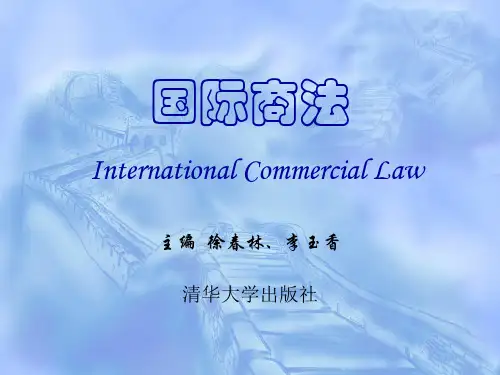

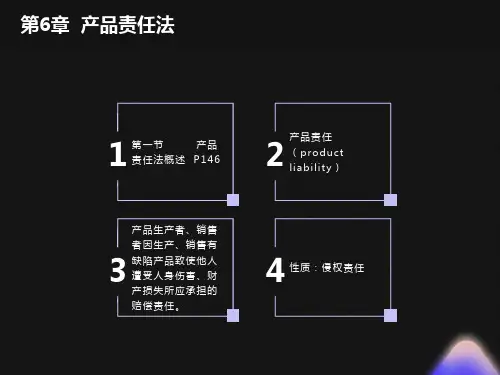
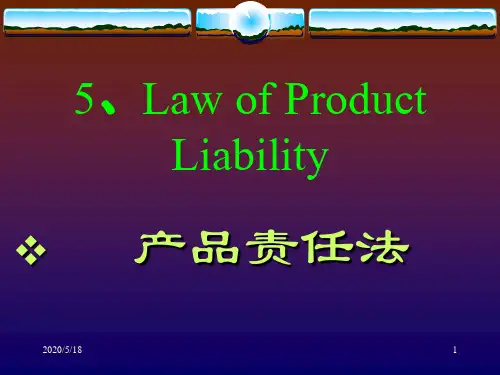


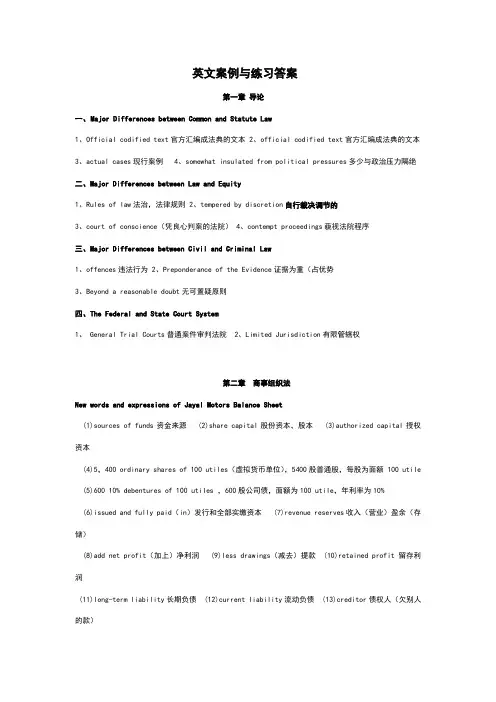
英文案例与练习答案第一章导论一、M ajor Differences between Common and Statute Law1、Official codified text官方汇编成法典的文本2、official codified text官方汇编成法典的文本3、actual cases现行案例4、somewhat insulated from political pressures多少与政治压力隔绝二、Major Differences between Law and Equity1、Rules of law法治,法律规则2、tempered by discretion自行裁决调节的3、court of conscience(凭良心判案的法院)4、contempt proceedings藐视法院程序三、Major Differences between Civil and Criminal Law1、offences违法行为2、Preponderance of the Evidence证据为重(占优势3、Beyond a reasonable doubt无可置疑原则四、The Federal and State Court System1、General Trial Courts普通案件审判法院2、Limited Jurisdiction有限管辖权第二章商事组织法New words and expressions of Jayal Motors Balance Sheet(1)sources of funds资金来源 (2)share capital股份资本,股本 (3)authorized capital授权资本(4)5,400 ordinary shares of 100 utiles(虚拟货币单位),5400股普通股,每股为面额 100 utile(5)600 10% debentures of 100 utiles ,600股公司债,面额为100 utile,年利率为10%(6)issued and fully paid(in)发行和全部实缴资本 (7)revenue reserves收入(营业)盈余(存储)(8)add net profit(加上)净利润 (9)less drawings(减去)提款 (10)retained profit留存利润(11)long-term liability长期负债 (12)current liability流动负债 (13)creditor债权人(欠别人的款)(14)employment of funds资金利用 (15)fixed assets固定资产 (16)motor vehicles机动车辆(17)current assets流动资产 (18)stock库存 (19)debtors债务人(别人欠的款)(20)bank money银行存款 (21)cash in hand持有现金 (22)cost价值 (23)accumulated depreciation累积折旧 (24)net book value帐面净值Answer the questions about Jayal Motors’ balance sheet。
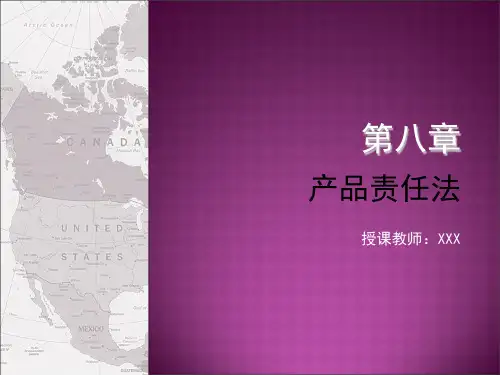
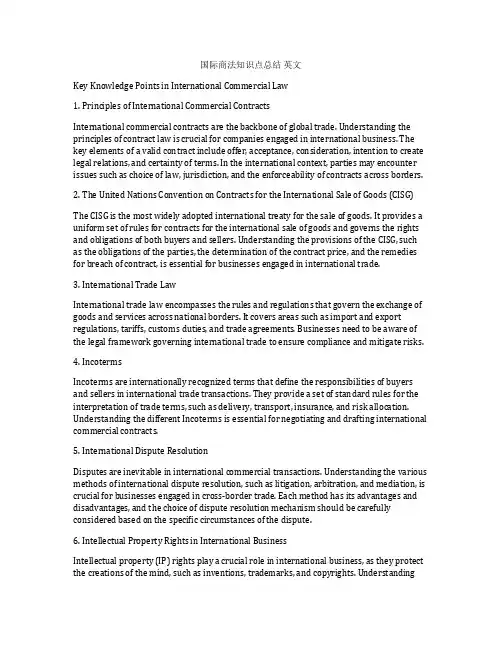
国际商法知识点总结英文Key Knowledge Points in International Commercial Law1. Principles of International Commercial ContractsInternational commercial contracts are the backbone of global trade. Understanding the principles of contract law is crucial for companies engaged in international business. The key elements of a valid contract include offer, acceptance, consideration, intention to create legal relations, and certainty of terms. In the international context, parties may encounter issues such as choice of law, jurisdiction, and the enforceability of contracts across borders.2. The United Nations Convention on Contracts for the International Sale of Goods (CISG)The CISG is the most widely adopted international treaty for the sale of goods. It provides a uniform set of rules for contracts for the international sale of goods and governs the rights and obligations of both buyers and sellers. Understanding the provisions of the CISG, such as the obligations of the parties, the determination of the contract price, and the remedies for breach of contract, is essential for businesses engaged in international trade.3. International Trade LawInternational trade law encompasses the rules and regulations that govern the exchange of goods and services across national borders. It covers areas such as import and export regulations, tariffs, customs duties, and trade agreements. Businesses need to be aware of the legal framework governing international trade to ensure compliance and mitigate risks.4. IncotermsIncoterms are internationally recognized terms that define the responsibilities of buyers and sellers in international trade transactions. They provide a set of standard rules for the interpretation of trade terms, such as delivery, transport, insurance, and risk allocation. Understanding the different Incoterms is essential for negotiating and drafting international commercial contracts.5. International Dispute ResolutionDisputes are inevitable in international commercial transactions. Understanding the various methods of international dispute resolution, such as litigation, arbitration, and mediation, is crucial for businesses engaged in cross-border trade. Each method has its advantages and disadvantages, and the choice of dispute resolution mechanism should be carefully considered based on the specific circumstances of the dispute.6. Intellectual Property Rights in International BusinessIntellectual property (IP) rights play a crucial role in international business, as they protect the creations of the mind, such as inventions, trademarks, and copyrights. Understandingthe principles of IP law and the international treaties and conventions that govern IP rights is essential for businesses engaged in cross-border trade, as it helps protect their intangible assets from infringement and unauthorized use.7. Cross-Border Mergers and AcquisitionsInternational mergers and acquisitions involve complex legal issues related to corporate law, antitrust law, and regulatory compliance. Understanding the legal framework governing cross-border M&A transactions, including the due diligence process, merger control regulations, and the negotiation and drafting of acquisition agreements, is essential for companies seeking to expand their global footprint through M&A activities.8. Compliance with International Regulations and StandardsInternational businesses need to comply with a myriad of regulations and standards, including those related to product safety, environmental protection, anti-corruption, and data privacy. Understanding the legal requirements and best practices for compliance in different jurisdictions is essential for maintaining the reputation and sustainability of the business.9. International Commercial ArbitrationArbitration is a widely used method for the resolution of international commercial disputes. Understanding the principles of international arbitration, including the selection of arbitration rules, the appointment of arbitrators, the conduct of arbitral proceedings, and the enforcement of arbitral awards, is essential for businesses engaged in cross-border transactions.10. Legal and Ethical Issues in International BusinessOperating in the global marketplace raises various legal and ethical challenges for businesses, such as bribery and corruption, human rights violations, and supply chain management. Understanding the legal and ethical issues in international business is crucial for companies to navigate the complex landscape of global trade while upholding ethical standards and corporate social responsibility.In conclusion, international commercial law is a vast and complex field that requires a deep understanding of legal principles, regulations, and customs that govern cross-border transactions. Businesses operating in the global marketplace need to be aware of the key knowledge points in international commercial law to ensure compliance, mitigate risks, and seize opportunities in the global economy.。
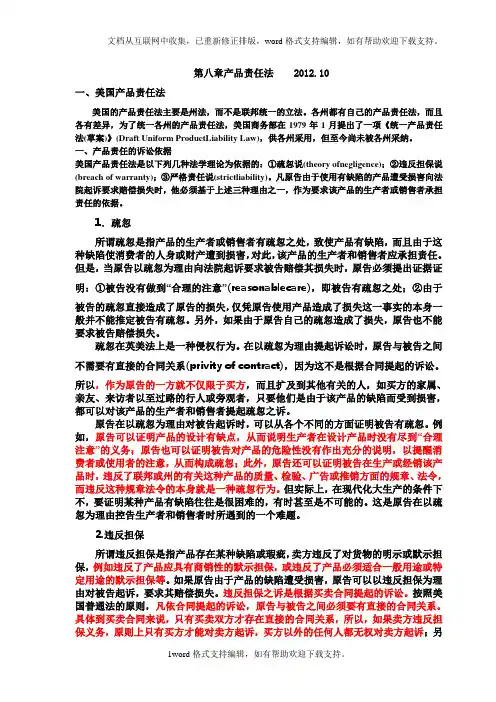
第八章产品责任法 2012.10一、美国产品责任法美国的产品责任法主要是州法,而不是联邦统一的立法。
各州都有自己的产品责任法,而且各有差异,为了统一各州的产品责任法,美国商务部在1979年1月提出了一项《统一产品责任法(草案)》(Draft Uniform ProductLiability Law),供各州采用,但至今尚未被各州采纳。
一、产品责任的诉讼依据美国产品责任法是以下列几种法学理论为依据的:①疏忽说(theory ofnegligence);②违反担保说(breach of warranty);③严格责任说(strictliability)。
凡原告由于使用有缺陷的产品遭受损害向法院起诉要求赔偿损失时,他必须基于上述三种理由之一,作为要求该产品的生产者或销售者承担责任的依据。
1.疏忽所谓疏忽是指产品的生产者或销售者有疏忽之处,致使产品有缺陷,而且由于这种缺陷使消费者的人身或财产遭到损害,对此,该产品的生产者和销售者应承担责任。
但是,当原告以疏忽为理由向法院起诉要求被告赔偿其损失时,原告必须提出证据证明:①被告没有做到“合理的注意”(reasonablecare),即被告有疏忽之处;②由于被告的疏忽直接造成了原告的损失,仅凭原告使用产品造成了损失这一事实的本身一般并不能推定被告有疏忽。
另外,如果由于原告自己的疏忽造成了损失,原告也不能要求被告赔偿损失。
疏忽在英美法上是一种侵权行为。
在以疏忽为理由提起诉讼时,原告与被告之间不需要有直接的合同关系(privity of contract),因为这不是根据合同提起的诉讼。
所以,作为原告的一方就不仅限于买方,而且扩及到其他有关的人,如买方的家属、亲友、来访者以至过路的行人或旁观者,只要他们是由于该产品的缺陷而受到损害,都可以对该产品的生产者和销售者提起疏忽之诉。
原告在以疏忽为理由对被告起诉时,可以从各个不同的方面证明被告有疏忽。
例如,原告可以证明产品的设计有缺点,从而说明生产者在设计产品时没有尽到“合理注意”的义务;原告也可以证明被告对产品的危险性没有作出充分的说明,以提醒消费者或使用者的注意,从而构成疏忽;此外,原告还可以证明被告在生产或经销该产品时,违反了联邦或州的有关这种产品的质量、检验、广告或推销方面的规章、法令,而违反这种规章法令的本身就是一种疏忽行为。
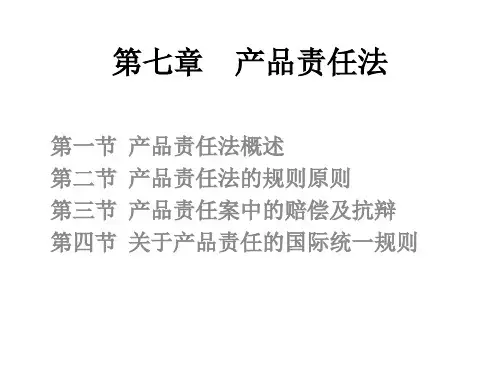
第七章国际产品责任法一、基本概念1.产品责任法(Product Liability Law):是国际商法的重要组成部分,既是调整国际货物买卖过程中可能发生的缺陷产品造成人身、财产损害等侵权行为的法律规范,也是保护消费者权利的核心制度。
在确定归责原则、责任主体、责任范围等问题时,更多的侧重于考虑消费者的利益。
2.产品(Product):是具有真正价值的、为进入市场而生产的,能够作为组装整件或者作为部件、零售交付的物品,但人体、组织、器官组成部分除外。
3.产品责任(Product Liability ):是因缺陷产品造成人身、财产损害而引起的损害赔偿责任。
4.缺陷:主要包括制造缺陷、设计缺陷、警示缺陷和说明缺陷。
对缺陷的判断采用“消费者期待”标准和“风险利益平衡”标准。
5.过失责任理论:指制造商或中间商因疏忽而造成其生产或销售的产品有缺陷,致使消费者遭受人身伤亡或财产损害应承担的赔偿责任。
疏忽责任原则适用于侵权之诉,它突破了合同关系的限制,原告只要证明制造商有疏忽,即使没有合同关系,也可以诉请其对有缺陷的产品所致损害承担赔偿责任。
6.严格责任理论(Theory of Strict Liability) :是指主要产品有缺陷,对消费者具有不合理的危险,且造成其人身伤亡或财产损害,该产品的生产者或销售者均应对此承担赔偿责任。
7.担保责任理论(Theory of Warranty):是指制造商或销售商违反了对货物的明示或默示担保,致使消费者由于产品缺陷造成损害,制造商或销售商应负担的法律责任。
担保责任原则适用于合同之诉。
二、重点问题(一)产品责任、产品质量责任与产品责任法在外国法中,产品责任是指产品生产者、销售者因生产、销售有缺陷产品致使他人遭受人身伤害、财产损失所应承担的赔偿责任。
产品责任法是确定生产者、销售者承担此种民事责任的法律规范的总称。
我国产品责任的主要规定见之于1993年的《产品质量法》中。
该法采用产品质量责任的概念。
第四章产品责任法第一节产品责任法概述一、产品责任与产品责任法产品责任是产品的生产者、销售者对于因其生产、销售的产品存在缺陷,造成消费者、使用者人身伤害或财产损失时应承担的赔偿责任。
产品责任所要解决的不是产品本身的质量问题,也不是在生产、流通领域中如何实行产品质量管理的问题,它所解决的是产品致人损害时的损失赔偿问题。
由于一般情况下产品责任最终要由产品的生产制造者承担,因此,产品责任又被称为产品制造者责任。
产品责任是伴随着现代化工业发展而出现的,是商品经济高度发达的产物。
18世纪末开始的工业革命,使得商品经济迅速发展,商品生产逐渐形成一些前所未有的特点,随之也带来了因缺陷产品造成的产品损害事故增多的现象。
对于产品造成人身伤害及财产损失的后果由谁来承担责任,受损害者是否应该得到赔偿,如何得到赔偿的问题日益为社会所关注。
为解决这个社会经济生活中不可回避的问题,相关的法律应运而生。
现代意义上的产品责任法最先诞生于英国,现已成为当今世界各国普遍重视的法律部门。
产品责任法不同于调整国家与产品生产者、销售者之间为保证产品质量而产生的管理与被管理、监督与被监督关系的产品质量管理法或产品质量监督法。
产品责任法所调整的是作为平等法律关系主体的产品生产者、销售者与消费者之间因产品损害事故而发生的损害赔偿关系,它以规定何种产品损害应获得赔偿、谁应对该损害承担赔偿责任、产品责任的归责原则以及产品责任诉讼等为内容。
产品责任法是调整有关生产与消费关系的最直接、最重要的法律之一,其精髓是平衡生产与消费之间的利益关系。
产品责任法在规定了生产者责任的同时,为消费者、产品使用者或者第三人的损害赔偿提供了法律依据与保障,从这个意义上说,产品责任法应属于消费者保护法。
二、产品责任的构成(一)关于产品从经济学上讲,产品是人们通过劳动手段对劳动对象进行加工形成的一定成果。
在商品经济条件下,产品不只是满足生产者自身的消费需要,更主要是为了满足社会的消费需要而进行生产的,此时的产品表现为从生产者手中通过市场交换到达消费者手中的商品。
要求包括:案情陈述;原告诉讼要点;本案例所涉及的重要法理和法庭裁决Major : __English_______ Class: _Three____ ___ Group: One Name Student ID汪杰20111301318曲溟20111301305马琼英20111301322刘银屏20111301323哈曼琳20111301327Report on Case 4-2IntroductoryBaxter’s (plaintiff), left eye was injured when the windshield of his car shattered. Plaintiff claimed that the trial court improperly excluded evidence in printed materials produced by the Respondent, Ford Motor Company (Respondent), claiming that the windshield was shatterproof.The plaintiff purchased a model A Ford form St. John Motors, a Ford dealer, who had purchased the automobile from the Respondent, Ford Motor Co. Plaintiff claims that representations were made to him by both the dealer and the manufacturer that the windshield of the automobile was made of glass that would not shatter. Respondent’s windshield was struck by a pebble, causing small pieces of glass to fly into his eye, resulting in the loss of his left eye and injuries to the sight of his right eye. The court took the case from the jury and entered judgment in favor of the dealer and the DefendantBasic Theory and Analysis:1. The warranty theory implies that there are some expectations associated with a product, and the manufacturer or seller can be held liable if the productfails to meet those expectations. In this case, the defendant advertised that “all of new Ford cars have a Triplex shatter-proof glass windshield-- so made that it will not fly or shatter under the hardest impact.” but we know that the car in question is not qualified with the requirement. So from this aspect we know that the defendant is liable.2. Express warranties are specific representations made by the manufacturer or seller about the quality of the product or its fitness for an intended purpose. The windshield of the plaintiff’s car was shattered by a pebble, which resulted in his losing an eye. He sued Ford Motor Company and the car dealer who sold him the car on the grounds that the company had advertised that the windshields on the cars were shatterproof. The Washington state court held that Ford’s marketing statements were an express warranty, and thus the company was liable for failure of its product to perform as expected.3. Breach of warranty refers to the failure of a seller to fulfill the terms of a promise, claim, or representation made concerning the quality or type of the product. The law assumes that a seller gives certain warranties concerning goods that are sold and that he or she must stand behind these assertions. The defendant in this case claimed that their cars can ensured the safety of the purchaser but they failed it. So the defendant is liable.4. Under strict liability, the manufacturer, seller, or distributor of a product can be held liable if the product is defective and is unreasonably dangerous to the consumer. As for this case, the defendant knew well that the cars’ windshield were not Triplex shatter-proof glass windshield and it can cause a disaster to the purchasers. Even knowing this the defendant did not reversed their action, so the defendant is liable.5. Misrepresentation in the advertising and sales promotion of a product refersto the process of giving consumers false security about the safety of a particular product, ordinarily by drawing attention away from the hazards of its use. In this case, the plaintiff have a strict liability cause of action, with no need to show negligence or privity, against the defendant that represented its products as possessing “All of the new Ford cars have a Triplex shatter-proof glass windshield, in fact, they do not possess,”and the plaintiff lost his left eye and injured the sight of his right eye as a consequence.6. Under the negligence theory, a manufacturer has a duty to make its product safe for users and is liable for damage or injuries caused by a product that is negligently or carelessly manufactured. Negligence is failure to make a safe product or to take steps to test a product to ensure that it is properly constructed for its intended use. In this case, the defendant knew that the general glass windshield could be danger to the purchasers so they claimed that their products were safe enough for the purchasers because the windshield of their cars “will not fly or shatter under the hardest impact”. Actually, they did not pay much attention to the quality of their windshield. So, the defendant is liable.Conclusion: Representations set forth by a manufacturer whose falsehood cannot be readily detected by a buyer may be relied on by the buyer regardless of an absence of privity of contract.JudgmentAppellant was provided with materials created by Respondent that claimed the windshield was made of shatter-proof glass. Respondent claims there can be no implied or express warranty derived from these materials because there isno privity of contract between Respondent and Appellant. Since Baxter bought the car from a retailer, has were not in privity with Ford and therefore had no standing to bring suit under contract law. However, Baxter noticed that the windshield had an express warranty that it would be "shatterproof." Since it was obviously not shatterproof, Baxter sued under tort law as fraud (by misrepresentation). The Court found that Baxter could recover for product liability claims under tort law. It did not rely upon the contractual obligations, but rather on the fact that the act of delivering an article is wrong due to the lack of the qualities of non-shatter-able windshield which the manufacturer represented the automobile as having. What’s more, when the injured party would be unable to discover the inherent problem with the product, permitting a manufacturer to create demand for its product by representing they possess qualities that they in fact do not, while barring recovery due to a lack of privity is unjust. So when the absence of quality could not be readily detected by the consumer, the article was improper to be published as the non-shatter-able glass was not safe enough to protect consumers against shatters. So the court held that the printed matters were improperly excluded and that Appellant had a right to rely upon these representations even without privity of contract between Appellant and Respondent. At the last, affirmed as to respondent St. John Motor.。